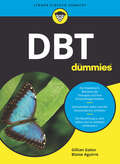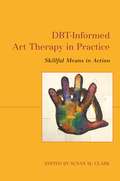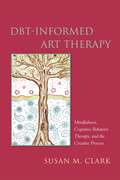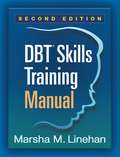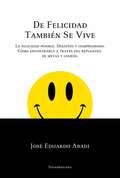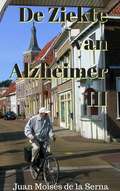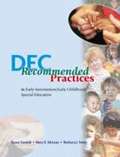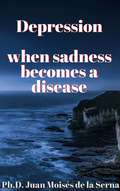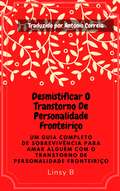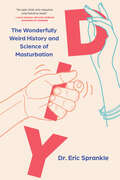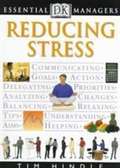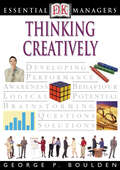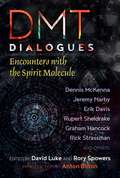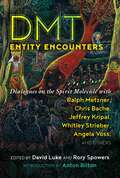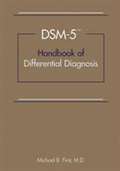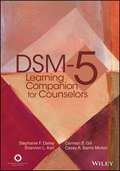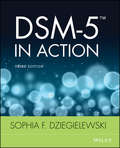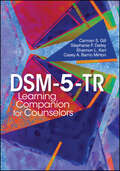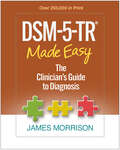- Table View
- List View
DBT for Everyone: A Guide to the Perks, Pitfalls, and Possibilities of DBT for Better Mental Health
by Michelle Henderson Kate ShermanDBT skills can be a fantastic way to approach life's challenges. But where do you start? This down-to-earth guide walks you through the four DBT modules, mindfulness, distress tolerance, emotion regulation, and interpersonal effectiveness. Each chapter explains how to practice the key skills and dives into the authors' own experiences to explore what works, what doesn't, and which skills work best for particular challenges. Journaling prompts help you work out how to fit the skills into your own day-to-day life, so you can make changes that work for you.DBT works by helping you to understand difficult emotions and develop skills to regulate them in a healthy way. Whether you struggle with mental health difficulties, or just want to improve the way you handle everyday stress and challenges, this book will filter out the jargon and show you how to use DBT skills in real life.
DBT for Everyone: A Guide to the Perks, Pitfalls, and Possibilities of DBT for Better Mental Health
by Michelle Henderson Kate ShermanDBT skills can be a fantastic way to approach life's challenges. But where do you start? This down-to-earth guide walks you through the four DBT modules, mindfulness, distress tolerance, emotion regulation, and interpersonal effectiveness. Each chapter explains how to practice the key skills and dives into the authors' own experiences to explore what works, what doesn't, and which skills work best for particular challenges. Journaling prompts help you work out how to fit the skills into your own day-to-day life, so you can make changes that work for you.DBT works by helping you to understand difficult emotions and develop skills to regulate them in a healthy way. Whether you struggle with mental health difficulties, or just want to improve the way you handle everyday stress and challenges, this book will filter out the jargon and show you how to use DBT skills in real life.
DBT für Dummies (Für Dummies)
by Blaise Aguirre Gillian GalenFällt es auch Ihnen manchmal schwer, Ihre Emotionen in den Griff zubekommen? Oder lassen Sie sich immer wieder von negativen Denkmustern runterziehen? Dann kann auch Ihnen die Dialektisch-Behaviorale Therapie (DBT), die Elemente der kognitiven Therapie und Verhaltenstherapie miteinander kombiniert, eine Hilfe sein! Dieser Leitfaden vermittelt leicht verständlich die Grundlagen der DBT. Erfahren Sie, wie Sie sich mit Achtsamkeit und Selbstakzeptanz das Leben leichter machen und emotionale Störungen, Depressionen, Phobien, Stress oder Angstzustände lindern können. Die Autoren liefern kreative Ideen, Behandlungspläne und Strategien und machen DBT für jeden zugänglich.
DBT-Informed Art Therapy in Practice: Skillful Means in Action
by Anthony Webster Emma Allen Jane DeSouza Yvette Duarte Penelope James Shelley Kavanagh Heidi Larew Scott Levson Melanie Paci Chloe Sekouri Megan Shiell Jeremy Steglitz Karin von von Daler Mary Weir Tracela M. ZapataResponding to growing interest in DBT-informed art therapy, this edited guide focuses specifically on how these interventions can treat a variety of client groups. Combining the structure and skill development of DBT with the creativity and non-verbal communication of art therapy can be a significant advantage in treating patients who are resistant to talking therapy. This book includes international contributors who cover work with a wide variety of populations, such as those with suicidal behaviours, eating disorders, and personality disorders. Divided in two parts, Part I focuses purely on DBT-informed art therapy, whilst Part II brings in multi-modal DBT-informed approaches, such as poetry and movement, but all with visual art as a component.
DBT-Informed Art Therapy: Mindfulness, Cognitive Behavior Therapy, and the Creative Process
by Susan M. ClarkUnderstand DBT-informed art therapy, and how to apply it to your practice. Dialectical Behavior Therapy (DBT) treats problems with emotion regulation, and is especially effective in treating chronic self-harming and suicidal behaviors associated with Borderline Personality Disorder. Combining the structure and skill development of DBT with the creativity and non-verbal communication of art therapy can be a significant advantage in treating patients who are resistant to talking therapy. This book gives a comprehensive overview of the growing literature and research on DBT-informed art therapy, drawing upon the work of pioneers in the field to explain different types of DBT-informed art therapy and the 'Three Ms' at its core: Mindfulness, Metaphor and Mastery. It also includes creative visual exercises and activities for developing the skills of core mindfulness, interpersonal effectiveness, emotion regulation, distress tolerance, and non-judgemental acceptance among clients.
DBT® Principles in Action: Acceptance, Change, and Dialectics
by Marsha M. Linehan MD Charles R. SwensonThe key to flexible, skillful decision making in dialectical behavior therapy (DBT) lies in understanding the connections between moment-to-moment clinical strategies and core principles. This lucid guide from leading DBT authority Charles R. Swenson offers clinicians a compass for navigating challenging clinical situations and moving therapy forward--even when change seems impossible. Numerous vivid case examples illustrate DBT in action and show how to use skills and strategies that flow directly from the fundamental paradigms of acceptance, change, and dialectics. Clinicians gain knowledge and confidence for meeting the complex needs of each client while implementing DBT with fidelity.
DBT® Skills Training Manual
by Marsha M. LinehanFrom Marsha M. Linehan--the developer of dialectical behavior therapy (DBT)--this comprehensive resource provides vital tools for implementing DBT skills training. The reproducible teaching notes, handouts, and worksheets used for over two decades by hundreds of thousands of practitioners have been significantly revised and expanded to reflect important research and clinical advances. The book gives complete instructions for orienting clients to DBT, plus teaching notes for the full range of mindfulness, interpersonal effectiveness, emotion regulation, and distress tolerance skills. Handouts and worksheets are not included in the book; purchasers get access to a Web page where they can download and print all the handouts and worksheets discussed, as well as the teaching notes.
DC: Diagnostische classificatie van psychische en ontwikkelingsstoornissen in de baby- en vroege kindertijd
by ZERO TO THREEDit boek gaat over de classificatie van psychische en ontwikkelingsproblemen bij zeer jonge kinderen vanuit het perspectief van de vroege ontwikkeling en de (relationele) context waarin zij opgroeien. Het is een belangrijk hulpmiddel bij het effectief gebruiken van diagnostische criteria ten behoeve van diagnostiek en behandelplanning. Het richt zich op hulpverleners en onderzoekers in de geestelijke gezondheidszorg, artsen, verpleegkundigen en opvoedkundigen. DC:0-5, Diagnostische classificatie van psychische en ontwikkelingsstoornissen in de baby- en vroege kindertijd is een vertaling van de grondig gereviseerde versie van de eerdere DC:0-3 (1994) en DC:0-3R (2005), het eerste en enige ontwikkelingsgerichte systeem voor diagnostiek van psychische en ontwikkelingsstoornissen bij kinderen tot en met vijf jaar oud. Er zijn verschillende redenen waarom een specifiek classificatiesysteem voor de baby en vroege kindertijd nodig is. Ten eerste, zijn de DSM-5 criteria niet zonder meer toepasbaar tot en met de leeftijd van vijf jaar; ten tweede, is het perspectief van de vroege ontwikkeling en die van de context waarin het kind opgroeit leidend in de DC:0- 5. Dit perspectief komt onvoldoende naar voren in de DSM-5. De DC:0-5 legt tenslotte grote nadruk op culturele diversiteit en de relevantie ervan voor de diagnostiek en behandeling. De DC:0-5 is een op zichzelf staand classificatiesysteem, maar slaat tevens de brug naar de DSM-5 en ICD-10. Nieuw aan deze editie: Leeftijd is opgerekt naar vijf jaar;De criteria zijn aangepast zodat ze beter van toepassing zijn op nog jongere en iets oudere kinderen; De relevantie van verschillen in culturele normen en waarden in de beoordeling wordt sterk benadrukt en hiervoor zijn praktische richtlijnen opgesteld. Ook is een aantal nieuwe stoornissen toegevoegd zoals: Vroege atypische autisme spectrum stoornis; Hyperactiviteit van de peuterleeftijd; Stoornissen in zintuigelijke verwerking; Stoornis van ontregelde woede en agressie van de vroege kindertijd, als vervanging voor de bekende oppositionele-opstandige stoornis (ODD). Diagnostic Classification of Mental Health and Developmental Disorders of Infancy and Early Childhood is oorspronkelijk uitgegeven door ZERO TO THREE: National Center for Infants, Toddlers and Families (2016). De Nederlandse vertaling is verzorgd door kinderpsychiater Janne Visser.
DE FELICIDAD TAMBIEN SE VIVE (EBOOK)
by Jose Eduardo AbadiDe qué se trata la felicidad? Existe? Llega de un modo azaroso, o es posterior a una búsqueda y a un trabajo acorde? Existe una felicidad posible para todos los seres humanos? José Eduardo Abadi, reconocido médico psicoanalista, asume el desafío de repensar el concepto de felicidad despojándose por completo de fórmulas simplificadoras. Abadi propone el "ser feliz" como la combinación armónica entre lo que se siente, lo que se piensa y lo que se hace. Si nos planteamos metas alcanzables, renunciamos al goce del sufrimiento y relegamos las fantasías que nos llevan a callejones sin salida, la felicidad es posible. Y no se trata, por ello, de una felicidad mediocre, sino de un intento de coherencia interior entre nuestros anhelos y la realidad. Estamos pensando la felicidad humana, ligada a nuestra condición de sujetos mortales, incompletos y en conflicto. Si esto queda anulado, se juegan engañosamente objetivos inalcanzables. Por otro lado, no podemos pensar la felicidad como un concepto aislado. Es importante articular lo individual con la relación con el otro, con la sexualidad, la pareja, la imaginación, la amistad y la sorpresa. Abadi nos acerca formulaciones sobre la felicidad que han realizado pensadores significativos en la historia del conocimiento. Veremos allí los puntos de coincidencia y disenso entre ellos y, sobre todo, qué lugar ocupan muchas de esas formulaciones en nuestro presente. De felicidad también se vive reabre un diálogo preexistente pero a veces dejado de lado en la sociedad: el camino hacia la búsqueda de la felicidad. Se trata de un libro necesario, inteligente y riguroso, como sólo un pensador de la talla de José Eduardo Abadi podría escribir.
DE ZIEKTE VAN ALZHEIMER III
by Luc Wyn Juan Moises de la SernaBoek beschrijving Hoe wordt ze behandeld? Hoe verspreidt ze zich? Hoe kan ze voorkomen worden? Leer meer over de laatste vorderingen en de behandeling van de ziekte van Alzheimer. Enkele van de voornaamste aspecten van een ziekte zijn hoe ze te overwinnen, of er een geneeswijze bestaat en wat de behandeling is. Er worden constant vorderingen geboekt met betrekking tot onderzoek naar de behandeling en preventie van de ziekte van Alzheimer, welke in deze tekst worden toegelicht. Doel: Het doel van dit boek is een eerste kennismaking te verlenen aan diegenen die zelf de ziekte van ALZHEIMER hebben of een familielid hebben dat eraan lijdt. Dit boek tracht op duidelijke wijze de resultaten van de meest recente research over de ziekte van Alzheimer naar voren te brengen, met het oog op het beantwoorden van de meest relevante vragen: Hoe behandelt men ze? Hoe is de voortgang? Hoe wordt ze voorkomen? Doelpubliek: - Personeel in de gezondheidssector dat zich wenst te verdiepen in de diagnose en de behandeling van de ziekte van Alzheimer. - Professoren die hun studenten bijgewerkte informatie over de ziekte van Alzheimer willen bieden. - Éénieder die een diagnose van de ziekte van Alzheimer ontving en hun familie zodat zij weten wat te doen met betrekking tot deze ziekte. Thema’s Hierna wordt elk van de hoofdthema’s van dit uiteen gezet: - Behandeling van Alzheimer: Ondanks de beperkte effectiviteit van de bestaande behandelings vormen, worden er elke dag nieuwe ontdekkingen gedaan gericht op het omgaan met deze ziekte. - Voortgang van Alzheimer: De ziekte van Alzheimer wordt gezien als een progressieve ziekte, wat betekent dat ze mettertijd de cognitieve vaardigheden doet verliezen van diegenen die eraan lijden. Ontdek hoe men dit bestrijdt. - Voorkoming van Alzheimer: Dit is misschien één van de minst bekende aspecten van de de meest recente ontdekkingen
DEC Recommended Practices In Early Intervention/Early Childhood Special Education
by Patricia Miller Susan Sandall Mary E. McleanOffers guidance to parents and professionals who work with children who are differently-abled and developmental delays.
DEPRESSION: when sadness becomes a disease
by Judith Tabullo Juan Moisés de la SernaLife is a succession of events, positive and negative situations, that will influence our way of thinking and behave, but also the way we feel. Sadness often comes from a loss or an experience we identify as negative, or simply because we haven’t fulfilled our desires. This sadness can be transitory, lasting hours, days or even weeks, but when it persists over time and changes the way we feel, think and act, we may be dealing with a bigger problem: depression.
DESMISTIFICAR O TRANSTORNO DE PERSONALIDADE FRONTEIRIÇO: UM GUIA COMPLETO DE SOBREVIVÊNCIA PARA AMAR ALGUÉM COM O TRANSTORNO DE PERSONALIDADE FRONTEIRIÇO
by Linsy B.TRANSTORNO DE PERSONALIDADE FRONTEIRIÇO DESMISTIFICADO Um guia completo de sobrevivência para amar alguém com transtorno de personalidade fronteiriço Linsy B. Pessoas com o transtorno de personalidade fronteiriço (BPD) podem ser amistosas de forma intensa num momento e depois extremamente horríveis no próximo. Caso esteja a ter dificuldades em manter uma relação estável com alguém que suspeita ter o transtorno, então este livro é para si. Este livro vai ajudá-lo a lidar com a natureza manipuladora do seu amigo, esposo ou membro familiar que tem BPD. Vai mostrá-lo as melhores maneiras de lidar com pessoas com BPD, dizendo-lhe algumas verdades difíceis. Irá perceber o porquê de eles fazerem o que fazem e a melhor maneira de lhes responder. Aprender a amar alguém com o transtorno de personalidade fronteiriço (BPD) envolve o estabelecimento de fronteiras, decidir se você quer todo o drama ou afastar-se. Este guia familiar essencial irá abordar: - Os efeitos do comportamento do BPD em si - O porquê de ir embora estar a ser difícil - As melhores maneiras de se manter com sanidade e, ainda assim, amar as pessoas com BPD
DIY: The Wonderfully Weird History and Science of Masturbation
by Eric SprankleThe first-ever social and scientific history of masturbation, which unapologetically critiques a system that has sought to control the very human desire for self-pleasure. Despite decades of medical and psychological research confirming that masturbation is healthy, the act remains shrouded in taboo and pseudoscience. In DIY, Dr. Eric Sprankle reveals the untold story of crusaders on a long campaign to suppress masturbation and the sex educators fighting back with science. He introduces readers to a colorful cast of characters: doctors advocating for the use of chastity devices, wellness influencers who believe ejaculation depletes the body of vital nutrients, pastors who preach that masturbation creates mermaids, and vibrator aficionados who teach the curious how to come. DIY will challenge what you think you know about the very human need for self-pleasure. Part sex-positive exposé, part fascinating science, DIY spotlights generations of sex education countering anti-masturbation pseudoscience with empowering truths about pleasure. This sex book is perfect for fans of Mary Roach books like Bonk or anyone curious about the history of sex and masturbation.
DK Essential Managers: Reducing Stress
by Tim HindleReducing Stress shows how to reorganize your work practices and think positively, plus it also provides practical techniques to use when dealing with potential problem areas.
DK Essential Managers: Thinking Creatively (DK Essential Managers)
by George P. BouldenThinking creatively is a key skill for any manager — whether you are finding solutions to seemingly intractable problems, generating new ideas, or thinking outside the box to bring your whole operation to a new level. Every type of business, no matter its outer appearance, can benefit from a creative approach, and barriers that people often take for granted can disappear with the right insight. This practical guide will not only show you how to think creatively, but also give you the skill set you need to inspire creativity in others, opening up new possibilities for your whole team. With key questions, exercises, and decision flow charts, Thinking Creatively will help you break your routines and unleash your creative potential. DK's bestselling Essential Managers books are ideal for managers at every level. These concise references demonstrate the techniques and skills that are useful in any work environment, making this series the most accessible single-subject business guides on the market.
DMT Dialogues: Encounters with the Spirit Molecule
by David Luke Rory Spowers Anton BiltonCutting-edge explorations and discussions of DMT experiences and plant sentience from leading luminaries in the field of psychedelic research• Includes contributions from Rupert Sheldrake, Rick Strassman, Dennis McKenna, Graham Hancock, Jeremy Narby, Erik Davis, Peter Meyer, David Luke, and many others • Explores DMT beings, plant sentience, interspecies communication, discarnate consciousness, dialoguing with the divine, the pineal gland, the Amazonian shamanic perspective on Invisible Entities, and the science behind hallucinations Encounters with apparently sentient beings are reported by half of all first time users of the naturally occurring psychedelic DMT, yet the question of DMT beings and plant sentience, interspecies communication, discarnate consciousness, and perhaps even dialoguing with the divine has never been systematically explored. In September 2015, ten of the world’s leading luminaries noted for exploring the mysterious compound DMT (dimethyltryptamine) gathered with other researchers at Tyringham Hall in England to discuss the subject. Over three days, they pooled their expertise from a wide range of subjects--archaeology, anthropology, religious studies, psychology, neuroscience, chemistry, and psychopharmacology, to name a few--to explore the notion of “entheogenic plant sentience” and the role of DMT as a conduit between Spirit and Matter. Offering cutting-edge insights into this visionary domain, this book distills the potent exchange of ideas that occurred at Tyringham Hall, including presentations and discussions on DMT entities, the pineal gland, the possibility of DMT as a chemical messenger from an extraterrestrial civilization, the Amazonian shamanic perspective on Invisible Entities, morphic resonance, and the science behind hallucinations. Contributors to the talks and discussions include many leading thinkers in this field, including Rupert Sheldrake, Rick Strassman, Dennis McKenna, Graham Hancock, Jeremy Narby, Erik Davis, Ede Frecska, Luis Eduardo Luna, Bernard Carr, Robin Carhart-Harris, Graham St. John, David Luke, Andrew Gallimore, Peter Meyer, Jill Purce, William Rowlandson, Anton Bilton, Vimal Darpan, Santha Faiia, and Cosmo Feilding Mellen.
DMT Entity Encounters: Dialogues on the Spirit Molecule with Ralph Metzner, Chris Bache, Jeffrey Kripal, Whitley Strieber, Angela Voss, and Others
by David Luke and Rory Spowers• Includes contributions from the late Ralph Metzner, Chris Bache, Whitley Strieber, Jeffrey Kripal, Angela Voss, Bill Richards, Chris Timmermann, Michael Winkelman, Luis Eduardo Luna, Anton Bilton, Bernard Carr, Daniel Pinchbeck, Dennis McKenna, Ede Frecska, and David Luke • Explores DMT beings, alien abduction, plant sentience, neuroscientific DMT research, the connections between LSD and DMT entities, and the nature of mind and reality Found throughout the plant and animal kingdom, DMT (dimethyltryptamine) is also naturally occurring in humans, where it is released during near-death and actual death experiences, earning it the title &“the spirit molecule.&” When taken as a psychedelic, either via ayahuasca or in pure form, DMT is experientially considered to be the strongest and strangest of all entheogens. The majority of high-dose users report visions of unknown yet curiously familiar alien worlds and encounters with sentient nonhuman presences. At a four-day symposium at Tyringham Hall in England in 2017, twenty of the world&’s psychedelic luminaries gathered to discuss entheogenic entity encounters, consciousness expansion, visionary experiences, and the future of research in this field. Contributors to the talks and discussions include many leading thinkers, including the late Ralph Metzner, Chris Bache, Whitley Strieber, Jeffrey Kripal, Angela Voss, Bill Richards, Chris Timmermann, Michael Winkelman, Luis Eduardo Luna, Anton Bilton, Bernard Carr, Daniel Pinchbeck, Dennis McKenna, Ede Frecska, and David Luke. This book distills the potent exchange of ideas that occurred at Tyringham Hall, including discussions on DMT beings, encounter experiences, alien abduction, plant sentience, the shamanic use of ayahuasca, neuroscientific DMT research, the connections between LSD and DMT entities, and the nature of mind and reality.
DOCTOR TO DOCTOR: Success Strategies Elevating Your Business & Personal Life
by Emily LetranThis book is a compilation of strategies for success covering multiple disciplines, such as medicine, dentistry, optometry, chiropractic, philosophy and pharmacy. We believe in the unity of health care professional to unite, share stories and help each other accelerate personal and business growth. Contributors: Kianor Shah, DMD, MBA Emily Letran, DDS, MS, CHPC Edward J. Zuckerberg, DDS, FAGD Kayvon Javid, DDS, DICOI, CPI Aura Imbarus PhD Susan Truong, MD Alan Chong, DC Gerald Morris, MD, MPH John Kriak, PharmD and The Dream Team of the Global Summits Institute
DSM-5 Handbook of Differential Diagnosis
by Michael B. FirstThis Handbook of Differential Diagnosis helps clinicians and students improve their skill in formulating a comprehensive differential diagnosis by including the DSM-5 classification and providing a variety of approaches, including a six-step diagnostic framework, 29 bottom-up "decision trees," and 66 differential diagnosis tables.
DSM-5 Learning Companion for Counselors
by Stephanie F. Dailey Carman S. Gill et. alWritten for an audience that includes private practitioners; counselors working in mental health centers, psychiatric hospitals, employee assistance programs, and other community settings; as well as counselor educators and their students. The DSM-5 Learning Companion for Counselors breaks down the concepts and terminology in the DSM-5 and explains how this diagnostic tool translates to the clinical situations encountered most frequently by counselors.
DSM-5 Learning Companion for Counselors
by Stephanie F. Dailey Carmen S. Gill Shannon L. Karl Casey A. Barrio MintonWritten for an audience that includes private practitioners; counselors working in mental health centers, psychiatric hospitals, employee assistance programs, and other community settings; as well as counselor educators and their students, this helpful guide breaks down the concepts and terminology in the DSM-5 and explains how this diagnostic tool translates to the clinical situations encountered most frequently by counselors. After describing the major structural, philosophical, and diagnostic changes in the DSM-5, the book is organized into four parts, which are grouped by diagnostic similarity and relevance to counselors. Each chapter outlines the key concepts of each disorder, including major diagnostic changes; essential features; special considerations; differential diagnosis; coding, recording, and specifiers; and, where applicable, new or revised criteria. Clinical vignettes help both clinicians and students visualize and understand DSM-5 disorders. Author notes throughout the text assist readers in further understanding and applying new material. *Requests for digital versions from the ACA can be found on wiley.com. *To request print copies, please visit the ACA website here. *Reproduction requests for material from books published by ACA should be directed to permissions@counseling.org.
DSM-5 in Action
by Sophia F. DziegielewskiFull exploitation of the DSM-5 allows for more comprehensive careBy demystifying the DSM-5, author Sophia Dziegielewski goes beyond the traditional diagnostic assessment and suggests both treatment plans and practice strategy. She covers the changes in criteria to the DSM-5 and what those changes mean for mental health professionals. This resource has been updated to include:New and updated treatment plansAll treatment plans, interventions strategies, applications, and practice implications are evidence basedInstructions on doing diagnostic assessments and differential diagnosis using the DSM-5Changes to coding and billing using the DSM-5 and ICD-10The book includes robust tools for students, instructors, and new graduates seeking licensure. DSM-5 in Action makes the DSM-5 accessible to all practitioners, allowing for more accurate, comprehensive care.
DSM-5-TR Learning Companion for Counselors
by Stephanie F. Dailey Casey A. Barrio Minton Carmen S. Gill Shannon L. KarlThis updated learning companion is designed to assist professional counselors with a smooth transition from the DSM-5 to the DSM-5-TR. The text highlights diagnostic changes and new developments within the DSM-5-TR. Each chapter features updated research with implications for evidence-based alongside practical strategies for holistic, culturally-responsive, and wellness-based counseling. As with the original DSM-5 Learning Companion for Counselors, this revision is intended for counselors, counseling students, counselor educators, and mental health professionals who engage in mental health diagnosis and evidenced-based services. The DSM-5-TR includes some important changes of which counselors must be aware, and this updated learning companion will help them incorporate these changes into practice. This new edition addresses these noteworthy changes specifically, delineating the differences and guidance, as well as case examples. To purchase print copies, please visit the ACA Store. Reproduction requests for material from books published by ACA or any other questions about ACA Publications should be directed to publications@counseling.org. ACA no longer provides complimentary print desk copies. Digital evaluation copies may be requested from Wiley by clicking the link above and completing the details about your institution and course.
DSM-5-TR® Made Easy: The Clinician's Guide to Diagnosis
by James MorrisonFully updated for the DSM-5 Text Revision (DSM-5-TR), this trusted guide presents the breadth of DSM diagnoses in an accessible, engaging, and clinically useful format. Master diagnostician James Morrison demystifies the dense DSM-5-TR criteria with more than 130 detailed case vignettes that illustrate typical patient presentations. Succinct descriptions of each disorder, along with many tips, sidebars, tables, and caveats, capture the intricacies of psychiatric symptoms and impairments to make accurate diagnosis cleaner and simpler. For DSM-5-TR, Morrison has incorporated the new diagnosis of prolonged grief disorder, updates to over 70 criteria sets, new and revised ICD-10-CM codes, and vignettes for additional subtypes. See also Morrison's Diagnosis Made Easier, Second Edition, which offers principles and decision trees for integrating diagnostic information from multiple sources; The First Interview, Fourth Edition, which presents a framework for conducting thorough, empathic initial evaluations; and The Mental Health Clinician's Workbook, which uses in-depth cases and carefully constructed exercises to build the reader's diagnostic skills.


